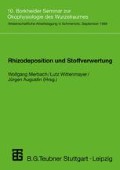Abstract
An application of 30 t dry matter/ha of biowaste compost contains nearly 6.6 t carbon and 1.7 t as cellulose C in addition to 2.6 t in the form of lignin C. Our field and incubation experiments indicate that in addition to the Nt concentration and the Ct/Nt ratio of the biowaste compost, the CaC12 extractable Corg/Norg and the lignin/Nt ratio are of great importance for the long term N mineralization. The short-term N mineralization was strongly influenced by the cellulose concentration of the biowaste compost. Application of lignin reduced the N mineralization caused by N immobilization. This potential of N immobilization in soil with repeated biowaste compost application was lower as that of the soil with mineral N fertilization. These results show that a repeated biowaste compost fertilization has a quantitative and qualitative influence on the N mineralization potential of soils.
Access this chapter
Tax calculation will be finalised at checkout
Purchases are for personal use only
Preview
Unable to display preview. Download preview PDF.
Literaturverzeichnis
Asche, E.; Steffens, D., 1995: Einfluß von Bioabfallkompost verschiedener Reifegrade auf Ertrag, N-Dynamik und Bodenstruktur im Feldversuch auf neun Standorten in Hessen. Kolloquium über die Verwertung von Komposten im Pflanzenbau vom 30. bis 31. Januar 1995 in Kassel. M. Budig, H. Schaaf, G. D. Schaumberg (Hrsg.) Hessisches Landesamt für Regionalentwicklung und Landwirtschaft, 59–74.
Mafongoya, P. L.; Nair, P. K. R.; Dzowela, B. H., 1998: Mineralization of nitrogen from decomposing leaves of multipurpose trees as affected by their chemical composition. Biology and Fertility of Soils 27, 143–148.
Popp, L.; Ebertseder, T.; Gutser, R.; Fischer, P.; Claassen, N., 1996: Prognose der kurzfristigen N-Wirkung von Komposten durch Kombination chemischer und biologischer Parameter. VDLUFA-Schriftenreihe 44, 397–400.
Author information
Authors and Affiliations
Editor information
Editors and Affiliations
Rights and permissions
Copyright information
© 2000 B.G.Teubner Stuttgart · Leipzig
About this chapter
Cite this chapter
Pape, H., Schmidt, S., Steffens, D. (2000). C- und N-Verbindungen aus Bioabfallkomposten und ihre Bedeutung für die N-Nachlieferung. In: Merbach, W., Wittenmayer, L., Augustin, J. (eds) Rhizodeposition und Stoffverwertung. Vieweg+Teubner Verlag. https://doi.org/10.1007/978-3-322-80025-1_1
Download citation
DOI: https://doi.org/10.1007/978-3-322-80025-1_1
Publisher Name: Vieweg+Teubner Verlag
Print ISBN: 978-3-519-00323-6
Online ISBN: 978-3-322-80025-1
eBook Packages: Springer Book Archive

